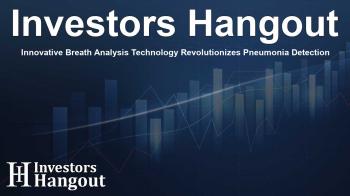Innovative Breath Analysis Technology Revolutionizes Pneumonia Detection

Revolutionizing Pneumonia Detection with Breath Analysis
Breath Diagnostics has showcased groundbreaking advancements with their patented OneBreath technology, indicating a new frontier in pneumonia diagnosis through the analysis of exhaled breath. Recent studies published in a prestigious medical journal highlight how this innovative approach can detect pneumonia even before symptoms manifest, paving the way for early interventions.
Understanding OneBreath Technology
OneBreath technology transforms a single exhale into significant diagnostic insights, representing a shift towards non-invasive medical testing. Ivan Lo, CEO of Breath Diagnostics, emphasizes the potential of exhaled breath as a diagnostic medium, noting its ability to identify diseases before clinical symptoms arise.
Clinical Study Insights
A clinical study involving patients who were scheduled for elective cardiac surgery explored the effectiveness of this technology. By collecting breath samples from these patients, researchers employed sophisticated machine learning techniques to analyze volatile organic compounds (VOCs), which serve as biomarkers for various health conditions.
The findings were remarkable: out of 75 patients, 10 developed postoperative pneumonia, a serious complication with lasting impacts on recovery and healthcare costs. The study revealed that the predictive model based purely on preoperative breath analysis could identify patients at high risk of developing pneumonia with similar accuracy as traditional diagnosis methods.
Why Early Detection Matters
Pneumonia affects 6–20% of patients post-cardiac surgery, significantly impacting recovery duration, healthcare expenses, and overall patient outcomes. Current preventative measures have often yielded inconsistent results due to the lack of reliable risk assessment tools. OneBreath technology addresses this gap by providing an innovative way to predict pneumonia onset, potentially transforming postoperative care.
Significance of the Research Findings
The study's results underscore the reliability of breath analysis as a preemptive tool for disease diagnosis. High-risk patients can now be identified days before clinical symptoms arise, enabling timely interventions that can reduce complications. This capability signifies a major leap forward in how medical professionals address postoperative care.
Broader Implications of Breath Diagnostics
The implications of this technology extend beyond pneumonia detection. Breath Diagnostics’ system not only offers rapid and non-invasive testing methods but also holds promise for other diseases associated with VOCs, including cancers and inflammatory disorders. By leveraging machine learning, the OneBreath platform can adapt and improve its predictive accuracy over time, revolutionizing healthcare.
Future Directions for Breath Diagnostics
Breath Diagnostics is poised to expand their research, aiming for larger multicenter studies that could enhance understanding of how breath biomarkers function across diverse patient populations. Collaborations with leading clinical partners are also underway to refine protocols for regulatory approvals, which will be crucial for integrating this technology into health systems.
Transforming Clinical Practice
The aim is to seamlessly incorporate predictive breath tests into surgical settings, fundamentally altering how clinicians approach patient care. By facilitating early detection and intervention, Breath Diagnostics aspires to lower healthcare costs and improve clinical outcomes for a wide range of surgical patients.
About Breath Diagnostics
Breath Diagnostics, Inc. is pioneering the field of non-invasive diagnostics through breath analysis. The combination of cutting-edge microchips, machine learning systems, and advanced analytical techniques forms the foundation of their innovative technology, which is on the brink of transforming early disease prediction.
Frequently Asked Questions
What is OneBreath technology?
OneBreath technology is a patented system developed by Breath Diagnostics that analyzes a patient's exhaled breath for volatile organic compounds (VOCs) to predict and diagnose pneumonia and other diseases.
How does breath analysis help in detecting pneumonia?
The analysis of VOCs in exhaled breath can identify biomarkers associated with pneumonia, allowing for risk assessment prior to the onset of symptoms.
What are the benefits of this technology?
The primary benefits include non-invasive testing, early disease detection, and potential for reduced healthcare costs through timely interventions.
What can Breath Diagnostics achieve in the future?
The company aims to expand clinical validation, gain regulatory approvals, and integrate their technology into hospitals to improve postoperative care across various surgical procedures.
How does machine learning enhance breath analysis?
Machine learning algorithms help refine the accuracy of predictions by analyzing complex datasets from breath samples, enabling the identification of at-risk patients effectively.
About The Author
Contact Lucas Young privately here. Or send an email with ATTN: Lucas Young as the subject to contact@investorshangout.com.
About Investors Hangout
Investors Hangout is a leading online stock forum for financial discussion and learning, offering a wide range of free tools and resources. It draws in traders of all levels, who exchange market knowledge, investigate trading tactics, and keep an eye on industry developments in real time. Featuring financial articles, stock message boards, quotes, charts, company profiles, and live news updates. Through cooperative learning and a wealth of informational resources, it helps users from novices creating their first portfolios to experts honing their techniques. Join Investors Hangout today: https://investorshangout.com/
The content of this article is based on factual, publicly available information and does not represent legal, financial, or investment advice. Investors Hangout does not offer financial advice, and the author is not a licensed financial advisor. Consult a qualified advisor before making any financial or investment decisions based on this article. This article should not be considered advice to purchase, sell, or hold any securities or other investments. If any of the material provided here is inaccurate, please contact us for corrections.

